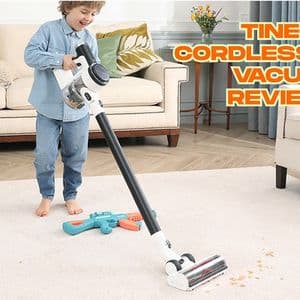Understanding Vacuum Cleaner Types
Let’s start with the basics.
Vacuum cleaners come in a wide range of styles, and each serves a different purpose. Understanding the key types can help you identify which format best suits your space and needs.
Upright Vacuums
These models are powerful, easy to store, and ideal for large floor areas. Upright vacuums generally offer excellent suction and motorized brush rolls, which makes them especially effective on carpets. However, they can be heavy and less maneuverable in tight spaces.
Canister Vacuums
Canisters offer strong suction with more flexibility. The wand design makes them easier to maneuver around furniture and up stairs. These are a solid choice for homes with a mix of carpet and hard flooring.
Stick Vacuums
Lightweight and easy to use, stick vacuums are perfect for daily upkeep. While early models lacked power, modern designs—such as the best stick vacuum units on the market—deliver excellent performance in a slim format. They're especially useful for apartments or quick cleaning sessions.
Handheld Vacuums
Designed for spot cleaning, handheld vacuums are portable and compact. They are not a full replacement for larger vacuums but are helpful for cars, furniture, and tight spaces.
Robot Vacuums
For those who prefer automation, robot vacuums can clean autonomously. They're best suited for low-pile carpets and hard floors but may struggle with deep cleaning or navigating complex layouts.
What Matters Most in a Vacuum Cleaner?
Let’s dig into the essential features.
Choosing the right vacuum isn’t just about picking a category. It’s about matching the machine’s capabilities to your household needs.
Suction Power
This is the backbone of any effective vacuum cleaner. Strong suction ensures deep cleaning of carpets and better pickup of fine dust on hard floors. For homes with pets or heavy foot traffic, suction power should be a top priority.
Filtration System
Look for high-efficiency particulate air (HEPA) filters if you suffer from allergies or asthma. HEPA filters trap microscopic allergens that standard filters may release back into the air.
Battery Life and Charging (For Cordless Models)
Cordless vacuums have come a long way. Models like the Shark cordless vacuum now deliver comparable performance to corded units with the added convenience of mobility. That said, always check the battery runtime and charging duration. If the vacuum runs for only 15 minutes per charge, it may not be practical for larger homes.
Dustbin Capacity
Smaller bins require frequent emptying, which can interrupt cleaning. Consider your space and cleaning frequency when evaluating bin size.
Weight and Maneuverability
A vacuum that’s hard to push or carry can quickly become frustrating. Stick and handheld models are generally easier to handle but may sacrifice some power or features.
Versatility and Attachments
Attachments like crevice tools, motorized brushes, and upholstery heads increase a vacuum's versatility. If you plan to clean various surfaces—like curtains, furniture, or stairs—these tools can make a big difference.
Corded vs Cordless: Which Is Better?
It depends on how you clean.
Corded vacuums are still the go-to choice for deep-cleaning sessions. They offer consistent power and no time limits. However, cordless models are increasingly closing the gap. Thanks to improvements in lithium-ion battery technology, many cordless vacuums now run long enough and strong enough for most households.
Cordless units also reduce tripping hazards and make it easier to clean cars, stairs, and out-of-reach places.
Common Use Cases and How to Choose
Let’s look at real-world scenarios.
For Apartments or Small Homes
If space is limited, a lightweight and compact stick vacuum might be ideal. These units are easy to store and quick to deploy. Look for models with wall-mounting options and multi-surface heads.
For Pet Owners
You’ll need strong suction and a motorized brush to lift pet hair from carpets and upholstery. Filtration is also key, especially for dander. Upright or high-performance stick vacuums with a HEPA filter are often the best choice here.
For Allergy Sufferers
A vacuum with a sealed system and HEPA filter is non-negotiable. This ensures allergens are trapped and not expelled back into your home’s air. Canister models with robust filtration often perform well in this area.
For Cars and Tight Spaces
In this case, portability is key. The best portable vacuum cleaner UK shoppers can find will offer a balance of size and suction, plus attachments to reach into crevices and upholstery.
Read more: best cordless vacuum cleaner
Key Considerations When Comparing Models
Don't skip this step.
Once you’ve narrowed down the type of vacuum that suits your home, compare models side by side using these criteria:
-
Suction rating: Compare actual performance, not just wattage.
-
Weight and dimensions: Especially important for storage and handling.
-
Noise level: Quieter models are better for shared living spaces.
-
Maintenance: Check how easy it is to clean filters and empty bins.
-
Warranty and reliability: A strong warranty often signals higher durability.
Final Thoughts
Choosing a vacuum is not just about brand recognition. This vacuum cleaners review has highlighted the importance of aligning features, design, and performance with your household’s unique needs.
Whether you’re seeking the best stick vacuum for everyday cleaning, exploring options like the Shark cordless vacuum for added mobility, or trying to find the best portable vacuum cleaner UK homes can rely on, your decision should rest on real-world usability. Consider where and how you clean, and weigh each feature against your lifestyle.
By following this expert guide, you’ll be better equipped to make a smart, lasting investment in your next vacuum.



















